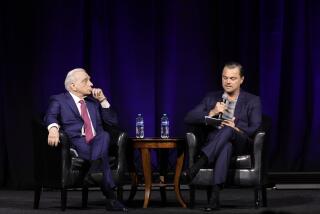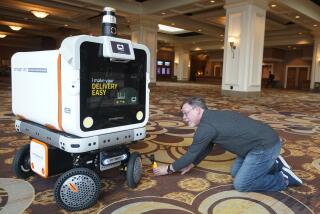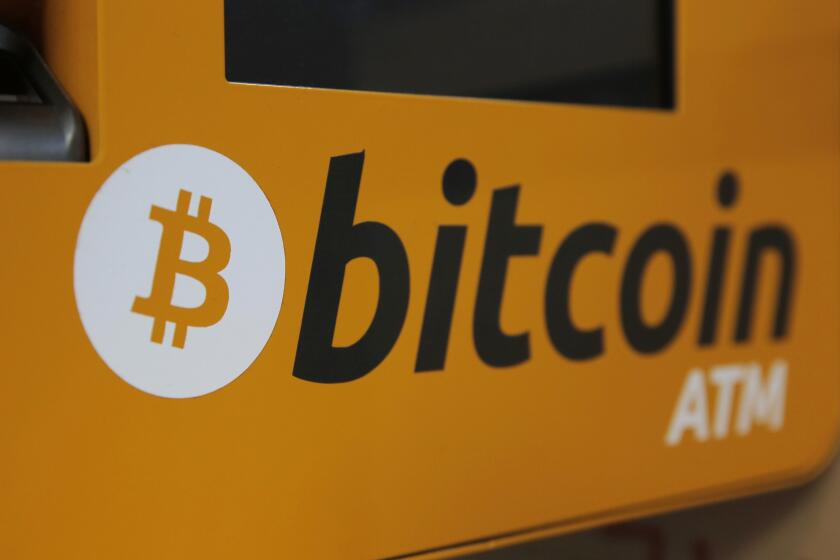CES Tuesday Roundup: Big TVs, big phones and a transparent TV
LAS VEGAS -- Walking around the Consumer Electronics Show on Tuesday, nothing stood out quite as much as watching a woman stick her hand behind a TV and then seeing her hand through the set’s transparent screen.
No, it wasn’t a magic trick. The Hisense employee was showing off the company’s see-through 3-D concept, which is a very thin TV with a transparent display. Many walking by the unusual TV made double takes as they couldn’t quite figure out what they were seeing.
The transparent TV sits about a foot away from a wall with a bright light behind it, which is necessary in order to see the images that appear on the set’s display.
In between the transparent screen and the light was an open space where Hisense had placed a small model of a village to demonstrate the TV’s transparent capabilities.
For now, there are no plans to bring this to the U.S., but the transparent TV will soon go into commercial use in China: Think a high-tech, souped-up display case.
-- Salvador Rodriguez
Is that a boombox? No, it’s a smartphone| 3:10 p.m.
That’s not a tablet you see tech executives holding up to their heads. It’s just their new, hip smartphones.
If there’s one thing that’s become quite clear at CES it’s that 5-inch-plus phones are no longer strange. In fact, they’re the norm here as more phone makers roll out oversized devices.
Just a year ago, a smartphone with a 4-inch screen was a big deal.
Now, companies including Samsung, LG and Lenovo are adding 5-inch screen devices every time they have a new announcement.
On Monday, for example, Sony announced that its new flagship phone for 2013, the Xperia Z, would also have a 5-inch display. The Xperia Z will also have another feature that’s becoming a trend among jumbo-sized phones: a full 1080p HD resolution.
For reference, that’s the type of display that was originally intended for 40-inch televisions. But that hasn’t stopped phone manufacturers, such as HTC with the Droid DNA and Vizio with a device it’s making for China.
And because 5-inch phones are starting to become common, some companies have begun to push the boundaries with even larger displays. Samsung last year announced the Galaxy Note II with a 5.5-inch display, and this week Huawei announced the mammoth 6.1-inch Ascend Mate.
I personally am not a fan of holding a brick up to my face and talking to it, but there’s no stopping this train now.
-- Salvador Rodriguez
Samsung unveils world’s first curved OLED TV| 2:20 p.m.
Samsung is showing off the world’s first curved, super-thin OLED TV at the CES exhibition center.
From afar, the TV looked like any other set that might be on display at a tech show, but once Samsung spokesman Scott Cohen pointed out the new gadget, I began to notice its unusual curved screen.
The picture quality was, unsurprisingly, remarkable and the weird curve didn’t really affect the way my eyes saw the image.
Cohen explained that the curved screen is intended to give viewers a more realistic and grand experience, similar to that of going to an IMAX movie theater. He also explained that the curved screen gives consumers more viewing angles where the picture appears just as it would if they were looking straight on at the TV.
As with most things at CES, Samsung did not announce a release date or pricing information for the TV. In fact, Samsung didn’t even provide a size for the curved display, but it looked to be about as big as one of their 55-inch OLED TVs.
--Salvador Rodriguez
Departing in five minutes: tours of CES| 2:05 p.m.
With 3,200 exhibitors and 1.9 million square feet of exhibition space, CES can be difficult to navigate even for the most ambitious techies.
So I guess I shouldn’t have been too surprised to see a gaggle of headphone-wearing attendees following a tour guide around LG’s gargantuan booth.
To avoid losing members of the group, the tour guide was accompanied by a bemused-looking assistant whose sole job appeared to be hoisting a large “Group M” sign above his head.
--Andrea Chang
Audi working on self-driving car with 3-D tech| 1:05 p.m.
Audi cars are stuffed with technology, with electronics making up “90% of innovations” at the German automaker, executives told a packed room during the CES convention Tuesday.
And, like Google and Lexus, Audi is trying to develop a self-driving car. The company said it has developed a laser scanning system that will be able to create 3-D maps of a vehicle’s surrounding, allowing computers to guide the car around obstacles.
A prototype shown at Tuesday’s talk, meant to be mounted on a vehicle’s grill, is much smaller than the bulkier towers being outfitted on the tops of other driverless test cars.
But, as Lexus officials made clear Monday, Audi executives stressed that they’re focused on “piloted driving,” not “autonomous driving” without any human input.
“Our ultimate responsibility rests ... with the driver,” said Ricky Hudi, Audi’s chief executive engineer of electrics and electronics.
Still, he said he believes that piloted driving “will become reality in this decade,” though he and other executives declined to speculate on a more specific time line. Japan and other areas with crowded downtown spaces will likely become first adopters, they said.
Other tech factoids: Every Audi A8 sedan has about 5,000 semiconductors. The connected nature of the company’s cars -- Wi-Fi-equipped “infotainment” systems, ingrained safety features that protect against impaired driving -- helps draw younger buyers.
About 46% of Audi owners are Gen X or Gen Y consumers, said Scott Keogh, president of Audi of America -- that’s more than other luxury rivals Lexus and BMW.
--Tiffany Hsu
Forget TVs, smart watches and wearable tech are in| 11:55 a.m.
The time has come for smart watches and other wearable tech.
I’ve checked out two companies so far at CES that are touting wristwatches that link up to your iPhone or Android device via Bluetooth.
The Martian watch, starting at $249, is a voice-command watch that connects to Siri or other smartphone voice-recognition services. So if you’re driving and receive a text, you can ask your watch to “read text” instead of digging around in your pocket or your purse for your phone.
Also, a line of $150 EZIO watches will alert you when your phone gets a call or text. It also protects against loss, alerting you if you get too far away from your phone.
Hong Kong company Faze in Limited is also working on jewelry versions. It also makes a wearable tech jacket, for $299, that heats up within 15 seconds for use in cold weather.
The Martian and EZIO watches are expected to go on sale this year.
--Andrea Chang
Vizio shows off glasses-free 3-D TV| 11:10 a.m.
While many in the industry are parading their 4K Ultra HD and OLED TVs, Vizio brought a different kind of technology to CES: a 3-D TV that doesn’t require viewers to wear 3-D glasses.
Although the technology might be a few years late with the interest in 3-D waning, seeing some innovation in TV was refreshing compared with many of the companies at CES that seemed to be rolling out the same old TV -- albeit with different names and specs.
The prototype television set allows users to get a 3-D effect without having to wear any glasses or watch the TV any differently than they would a regular set. The image quality isn’t as high as the 3-D you get with glasses, but then again, this is just a prototype.
Additionally, if you do step outside the viewing area where you see the image in 3-D, the picture won’t become blurry -- you’ll simply see it in regular 2-D.
Despite the high marks for uniqueness, Irvine, Calif.-based Vizio played it a bit safe and did bring along its own 4K Ultra HD TV, which it set up next to the glasses-free prototype. Vizio hopes to release the TV by the end of 2013.
--Salvador Rodriguez
Panasonic offers up 4K OLED TV, ‘warm fuzzies’| 10:50 a.m.
Kicking off the first official day of the 2013 International Consumer Electronics Show, Panasonic CEO Kazuhiro Tsuga did his best to stir our gadget lust and our emotions.
There were flashy gadgets, a pregnant Lisa Ling on stage, loads of baby videos, and the always inspirational Newark Mayor Cory Booker.
Tsuga aimed for the big picture, talking about the accelerated pace of change, and how it impacts both consumers and Panasonic.
When it comes to new technology: “The next five years will transform more than the last 25,” Tsuga said. “Clearly, customers are hungry for this.”
But the biggest piece of eye candy during the hour-long presentation was bound to be the Panasonic 4K OLED TV that Tsuga showed on stage. Sony made a lot of noise on Monday by claiming to have the first and only.
Not any more.
The 56-inch screen on Panasonic’s 4K was glorious. Even more astonishing: This bad boy was only one-half inch thick. Let me repeat: One-half inch thick. This is for a TV folks.
Price and availability were not announced. But if this is the future, it can’t get here fast enough.
And to really get your juices flowing, Panasonic execs gave just the briefest glimpse of their coming 20-inch Windows 8-based 4K tablet. Again, no price or availability date. But still, yum factor is high.
Tsuga also talked up the expanded interactive features being added to its Panasonic Viera smart TVs. Panasonic is trying to embrace more interactivity and more second-screen activity. All of that will allow for greater personalization of the TV’s home screen, it’s menu, and for new social features.
Just as important, that’s going to allow Panasonic and content creators to get loads more information on users’ behavior. And that will enable them to soon start targeting TV ads to individuals. And of course, this is going to put a mile-wide smile on the faces of advertisers and TV producers everywhere.
Panasonic shows off 20-inch, 4K tablet| 9:50 a.m.
Here’s something to stimulate your saliva glands.
Panasonic just gave us a glimpse of a 20-inch 4K tablet. No word on price or availability. But boy howdy, it looked pretty darn sweet. See a picture here:
https://twitter.com/obrien/status/288699929852006400/photo/1
Let’s ban ‘game changer’ from tech show| 9:10 a.m.
During the first, exhausting, mind-numbing day of press conferences at the 2013 International Consumer Electronics Show, one phrase kept rearing its ugly, horned head: game changer.
A good rule of thumb is that whenever someone says, “This is a game changer,” then it isn’t. Still, the phrase proved irresistible, even when the products being discussed were perfectly resistible.
At Intel’s press conference, a bizarre intro video climaxed with a nuclear fireball giving way to the words, “WELCOME TO THE NEXT GAME CHANGER.”
According to ZDNET: “Broadcom reps have described the BCM7445 UltraHD TV decoder solution as “a game changer for big screen and Internet video in the home.”
From Forbes: “The Caliber Advantage is a game-changer for the mobile platform,” said Kent Wuthrich, executive vice president of marketing for ZAGG.
Well, you get the picture. So as things get rolling at CES on Tuesday, let’s try to have some fun with this. Every time you hear someone say “game changer” tweet #gamechanger. Whoever writes the most #gamechanger tweets wins.
Sadly, the prize will simply be intrinsic. And maybe all the Los Angeles Times tech writers at CES will include you in a #FF.
It’s gadget day, and Panasonic kicks it off| 7:25 a.m.
Now it starts for real.
After a couple of days of pre-show hype and announcements mainly geared toward the press, the 2013 International Consumer Electronics Show officially gets underway as more than 150,000 people are expected to cram into the Las Vegas Convention Center to mix, mingle and be dazzled by the latest digital goodies.
Early Tuesday, things get rolling with the keynote address by Kazuhiro Tsuga, the incoming president of Panasonic Corp. Panasonic already gave a preview of its latest Viera smart TVs on Monday.
Tsuga is expected to further elaborate on how his company will make viewing more interactive, and how it will try to tap into the second-screen phenomenon.
The massive trade show floor will then open, welcoming a sea of humanity. According to the Consumer Electronics Assn., which sponsors the show, CES will draw more than 150,000 attendees, close to the 156,153 who attended last year. They get to poke and prod gadgets from more than 3,100 exhibitors across 1.862 million square feet.
They can expect to see and hear a lot about mobility, cloud, and connected devices.
Highlights from Monday’s press day included word that the world’s first OLED HD TV will hit the U.S. market in March for a cool $12,000.
And Sony gave a preview of the world’s first OLED 4K TV, a 56-inch set that is still a prototype.
The day was capped by the pre-show keynote by Paul Jacobs, chief executive of Qualcomm. Jacobs brought out guests like Maroon 5 and Microsoft chief executive Steve Ballmer to amp the crowd up.
Stay tuned for more.
Maroon 5 caps off star-studded Qualcomm event| 8:25 p.m. Monday
Qualcomm had big shoes to fill when it took over the plum pre-show keynote spot from Microsoft. And it began with an awkward live skit from three actors on stage talking about the importance of mobile.
Paul Jacobs, chief executive of Qualcomm, took it from there, and things got better.
The San Diego company trotted out a slew of surprise guests, starting with Ballmer. It was a curious move given Microsoft’s announcement a year ago that it was pulling out of CES starting with the 2013 show.
After Ballmer showed off some of the latest Windows Phone devices, Jacobs unveiled Qualcomm’s new Snapdragon 800 series, which he called the most advanced wireless chip ever built.
Snapdragon 800 leverages the power of advanced LTE and is “fast enough to stream high-def video anywhere,” he said. The chip improves connectivity and will be available in the second half of this year.
To demonstrate the chip, Qualcomm brought out writer-director Guillermo del Toro of “Hellboy” and “Pan’s Labrinyth,” who gave the crowd an ultra HD preview of his upcoming movie “Pacific Rim.”
Also taking the stage at the keynote: NASCAR driver Brad Keselowski and Big Bird, who demonstrated mobile apps. There was also a preview of the new “Star Trek” and an appearance by actress Alice Eve.
Qualcomm’s event was capped off by a performance by Maroon 5.
-- Andrea Chang
Sony unveils world’s first OLED 4K TV| 6:35 p.m. Monday
In a show filled with bright lights and bumping music, Sony gave a peek at its plans by unveiling the world’s first OLED 4K TV at CES.
The 56-inch set is a prototype, but it is the first to combine OLED and 4K, both of which are considered the next step in TV technology. OLED provides higher quality images and allows for thinner displays while 4K, also known as Ultra HD, has a resolution four times that of full 1080p HD.
Although the OLED 4K set did provide an incredible image, it didn’t take long for it to show why it’s just a prototype. As Sony CEO bragged about the TV’s high-quality picture, the display stopped working and simply showed a blue screen. It was an embarrassing moment in an otherwise impressive event where Sony announced numerous major products that will be launching in 2013.
Among them are 65-inch and 55-inch 4K TVs that will join an 84-inch model Sony released last year. Sony placed some of its 4K screens side by side with regular HD displays, showing the difference.
The 4K displays seemed to provide a brighter picture. The new 4K models are set to arrive some time this spring.
For the smartphone market, Sony unveiled its next flagship phone, the Xperia Z, which is set to arrive in the first quarter of 2013.
The Xperia Z features a 5-inch 1080p HD display and has a 13-megapixel rear camera. The pictures it took were very sharp and looked excellent on the display.
The Xperia Z, which is water and dust resistant, uses a 1.5GHz quad-core Snapdragon S4 processor and is LTE enabled. LTE is the latest technology in cellular high-speed Internet access.
No prices were given on any of the products.
-- Salvador Rodriguez
Samsung unveils multi-view TV, smart fridge| 4:05 p.m. Monday
Samsung announced to a packed house at CES a litany of new products and features, from a smart refrigerator to a multi-view TV.
Starting with the biggest splash, Samsung showed off a series of new-generation TVs. Among them was a 55-inch OLED TV with multi-view — great for indecisive couples who just can’t wait to watch their shows. It allows two viewers to watch different content on the same screen at the same time using glasses with individual speakers.
Then there was an 85-inch, impossibly thin, ultra-high-definition TV with four times the pixel density of LED TVs. Speakers are embedded in the screen, offering 120 watts of sound.
The best part of the presentation might have been that you can give your 2012 Samsung TV a brain transplant with its Evolution Kit. This would add the smart hub, recommendations that let you comb video-on-demand from multiple sources with one search and quad-core processing.
On the mobile front, the new Samsung cameras can transfer photos directly over to Samsung mobile devices for better sharing and photo editing. They also can shoot 3-D video and stills.
Samsung also announced that a 4G LTE Galaxy Note 10.1 is coming to Verizon this month. It will use Google’s Jelly Bean operating system.
And Samsung then showed off what may be the ultimate refrigerator, the T-9000.
This terminator of a icebox is a French-door designed fridge with four doors. Depending on your needs, it can convert unneeded freezer space into additional fridge space. Plus, it has apps and can communicate with your Samsung mobile devices to do everyday household chores including monitoring your baby sleeping in the next room.
— Michelle Maltais
Intel unveils tools for human-like computing| 3:15 p.m. Monday
No word on an empathy algorithm yet, but Intel announced a series of tools at CES Monday to make our computers more human-like.
Intel’s director of perceptual computing, Achin Bhowmik, demonstrated how Intel was seeking to enable computers with qualities such as sight, hearing, voice and touch.
For instance, rather than using a password, Bhowmik accessed his PC account using new facial-recognition software.
He also showed how the computer could be controlled using gesture recognition (goodbye, mouse!).
And then he played a game of “Where’s Waldo?” in which the computer’s camera tracked his eyes as he looked for Waldo. When he looked at the place where Waldo was located, a ping told him he was correct.
At the moment, many of the features would require users to buy additional peripherals. But Intel says it expects them to be built right into future Ultrabooks and other laptops.
— Chris O’Brien
Huawei’s reply to iPhone: drop-proof phone| 2:53 p.m. Monday
Huawei unveiled a 6.1-inch-screen smartphone Monday, but it was how the company’s CEO treated the phone that really surprised those in attendance at CES.
Richard Yu said the Ascend Mate and its smaller sibling, the 5-inch Ascend D2, are dustproof and waterproof. To make his point, he held one of the phones over a tank and poured a pitcher of water over it.
Yu then walked back to the center of the stage and talked about the two phones’ durability. He dropped the device, picked it up and said you could do the same on a rocky road and the smartphone would come away without cracking its screen.
Besides being seemingly accident-proof, both have HD screens. The larger Ascend Mate features a 720p HD display while the Ascend D2 boasts a 1080p HD display.
Never heard of Huawei? The Chinese company is now the world’s largest telecom equipment maker.
— Salvador Rodriguez
Lexus unveils intelligent, self-driving car| 11:55 a.m. Monday
A smart gadget with four wheels is turning heads at CES.
Lexus’ Advanced Active Safety Research Vehicle is shiny, slathered in gadgetry and giving Google a run for its (substantial) money. But the intelligent, self-driving car won’t reach consumers any time in the near future.
In a presentation at the Consumer Electronics Show, Lexus General Manager Mark Templin stressed that although “machines can handle simple tasks” like parking and drift avoidance, “sensing what’s around you and understanding it is vastly different.”
Lexus’ effort is still a “pure research project” that needs to “build trust with society and governments,” Templin said. Down the line, however, its ability to anticipate its own trajectory, identify green lights from red and scan surrounding movements could become routine.
— Tiffany Hsu
Panasonic launches new Viera smart TV| 10:40 a.m. Monday
Panasonic’s news conference at CES has started. First up, the company is announcing a new version of its Panasonic Viera smart TV.
Which means, of course, the Panasonic Viera I bought last year is basically toast. But that’s life.
In any case, the latest version of the Viera is to offer several new features. For digital content, instead of having to switch between different digital channels or apps, users will be able to organize and view all their digital from something called “My Homescreen.” In addition, each family member can customize the screen to display their favorite digital content.
Also, a camera on the TV will recognize the user and switch to that person’s customized home screen. The new Viera TVs also come with a voice-activated remote control.
And there is now a touch pen that activates the TV screen. Want to display a photo from your smartphone on the TV? Touch the screen with the touch pen and it brings up an editing menu. Edit the photo with the pen, and then save it back to your mobile devices.
If you have your TV mounted above the fireplace (like me), this might be awkward. But, whatever. It’s still cool.
— Chris O’Brien
Sharp says bigger is better with 90-inch LED TV| 10:25 a.m. Monday
Two months after confessing “material doubts” about its chances of survival, Sharp made a case for its continued relevance at CES with a slew of large-screen, high-definition televisions.
The Japanese company pulled back the curtain -- literally, a massive red one -- to show off its gargantuan 60-, 70-, 80- and 90-inch Aquos LED televisions at a news conference Monday.
The 90-inch behemoth — which Sharp said will be the “largest commercially available LED TV” — is to reach stores in March.
Large-screen models have more than quadrupled their share of the television market’s revenue, to 20% last year from 4% in 2010, said John Herrington, president of Sharp Electronics Marketing Co. America.
“For U.S. consumers, bigger is absolutely better,” he said, adding that Sharp plans to have 21 such products on the market this year.
Other television innovations from the company include a split-screen function that allows users to surf the Web and watch television on the same screen. A new app will turn Android and iOS devices into a remote control. So-called 8K resolution -- 16 times the pixel resolution of HDTV -- and Quattron color upgrades could make television viewing even more striking and realistic than looking out a window.
Sharp also teased a screen surface technology, dubbed Moth Eye for its insect-like ability to eliminate glare and reflection, in development for 2014.
Also on display: The company’s IGZO (indium, gallium, zinc, oxygen) compound semiconductor, which executives said will offer better resolution and better battery management when used in televisions, monitors and mobile devices. Applications include displays used by doctors and financial traders, said executive vice president Kozo Takahashi.
The technology was included in a smartphone launched in the Japanese market late last year and will be rolled out in more devices this year.
As for the compan’’s balance sheet woes? Chief Executive Toshi Osawa told the scrum that labor costs and inventory have decreased and that the U.S. business is headed for its third year of double-digit growth.
“The changes are already showing themselves,” he said.
— Tiffany Hsu
LG rolls out big-screen OLED, Ultra HD TVs|9:05 a.m. Monday
LG’s 55-inch OLED HD TV will go on sale in the U.S in March for $12,000, the company announced Monday at the 2013 International Consumer Electronics Show.
The LG set is the first big-screen OLED TV and was on display at CES on Monday morning. Even from across a ballroom floor, the set provided crystal clear images while running a demo video.
Besides OLED, LG also announced it will expand its line of Ultra HD TV sets with two more sizes: 65-inch and 55-inch sets. They join an 84-inch, $20,000 model that launched in 2012.
LG didn’t announce pricing or availability of the new Ultra HD models, which display images with four times more detail than the standard high-definition TVs.
— Salvador Rodriguez
Ultra-high-def TV, organic-LED sets, celebs, surprises|8 a.m. Monday
Monday is Press Day at the International Consumer Electronics Show, when many of the biggest tech companies host flashy press conferences for thousands of reporters and bloggers.
The hoopla kicks off Monday morning with a press conference from LG, followed by events from Sharp, Panasonic, Samsung and other device makers. Expect bigger ultra-high-definition televisions, new organic-LED sets, improved smart TV platforms and surprise celebrity appearances.
Later on in the day, a select group of smaller tech companies will showcase their latest gadgets, accessories and apps at the Digital Experience media event at the MGM Grand.
Highlights from Sunday’s sneak peek day included the “smart electronic” Hapifork, which buzzes in your hands when it determines you’re eating too quickly. This apparently fosters both mindful and mindless eating.
“Your mind doesn’t have to do the work,” says inventor Jacquest Lepine.
Also, 3M and Lenovo demonstrated their table-top PCs, which allow multiple users. Lenovo’s IdeaCentre Horizon Table PC is easy to picture in your living room. 3M went big with an 84-inch multi-touch system aimed at the business market.
Meanwhile, Belkin unveiled the Thunderstorm, billed as the first-ever handheld home theater case for the iPad.
Stay tuned for more.
More to Read
Inside the business of entertainment
The Wide Shot brings you news, analysis and insights on everything from streaming wars to production — and what it all means for the future.
You may occasionally receive promotional content from the Los Angeles Times.










